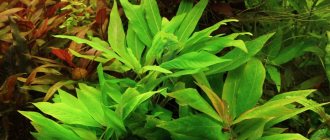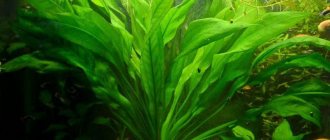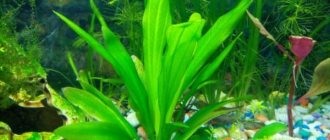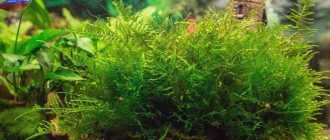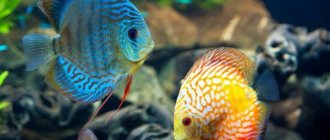Echinodorus tenderus or “Dwarf Amazon” is very popular among aquarists: from beginners to avid lovers of the underwater world at home. The plant received its second name “Gentle” due to its ability to form bushy thickets , reminiscent of a soft fleecy covering lined along the bottom of the aquarium. The plant has bright green elongated leaves about 5 cm long; bushes rarely grow more than 10 cm in height. The leaf blade is narrow to 0.5 cm at the rhizome, wide in the middle and pointed towards the end of the leaf. The leaves come from a small rhizome, which has a fragile structure and is sensitive to frequent transfers from one part of the aquarium to another.
Description
Belongs to the chastukha family. A related species is Echinodorus tender rubra. This species is distinguished by its unpretentiousness in maintenance, compared to its close relatives. Echinodorus rubra is a taller plant (up to 17 cm in height) and has thinner leaves. A distinctive feature of Echinodorus rubra is the purple color of the leaves.
Compatibility with other aquarium cultures
Echinodorus tender gets along well with other types of aquarium plants. The main thing is that they do not greatly exceed the height of the Dwarf Amazon. Plants that are tall or floating on the surface of the water will block the passage of sunlight, and this will have a detrimental effect on Echinodorus.
The Dwarf Amazon will coexist normally with tall plants only if it is planted directly next to the aquarium walls, which will provide optimal side lighting.
Content
Difficulty in content . This aquarium species is not demanding in terms of maintenance, so it is often chosen by beginning aquarists. The only important requirement is to provide high-quality lighting and water filtration. Otherwise, the plant will slow down its growth, lose color and wither. In all other respects, this species does not differ in demandingness from other inhabitants of aquariums.
Requirements for an aquarium . Echinodorus is low (up to 10 cm), so it is advisable to select a tank with low walls for optimal light transmission through the water column. A size of 25-45 cm is the ideal height of the aquarium walls for the comfortable growth of Echinodorus. The area of the bottom of the aquarium depends on the owner of the aquarium: the more bushes you plan to plant, the larger the area of the aquarium should be.
Soil . A fine, well-silted substrate, 1 to 3 cm thick, is suitable. A thick layer of soil is not necessary, since the rhizome is fragile and small. If you choose soil consisting of large stones, for example pebbles, Echinodorus will grow unevenly and sparsely, which will spoil its decorative qualities.
Environment Settings . Echinodorus does not require special maintenance of the water composition. A comfortable environment for Echinodorus will be created by water at room temperature 22-25°C, with hardness parameters of 6-16 °dH (medium hardness) and acidity from 6 to 8 Ph. Too soft water will have a detrimental effect on bushy foliage and it will quickly lose its volume. If the water is too cold, the plant may slow down its growth or die. The plant does not tolerate a dirty pond; the water must be changed in parts (no more than a third of the total volume at a time) once a week.
Lighting . Echinodorus is sensitive to light. The plant needs a large amount of light, both natural and artificial. It is not recommended to expose it to direct sunlight, as it can easily damage the delicate leaves of the plant. Sunlight should be diluted with a houseplant or curtain in front. At night, natural light can replace low or medium power fluorescent lamps (0.5 W/l). If Echinodorus does not receive enough light, its dense, bright green thickets will lose their color and shape. The leaves will become more elongated and thinner, as they will be drawn towards the light source. The plant must be illuminated for at least 12 hours a day.
Filtration . The plant will grow better in well-purified water. Muddy, dirty water is not able to transmit enough light through it. And since the Echinodorus plant does not grow tall, light will pass to its foliage from top to bottom only when the water is completely transparent and there are no floating particles of dirt, food or algae.
The video shows a plant in an aquarium
Echinodorus red
There are several varieties of this plant variant found in aquariums. Echinodorus "Red Diamond" is a hybrid of E. barthii and E. horemanni "red". It is a very attractive plant, distinguished by ruby-red, sword-shaped leaves. While the leaves are young, they have a reddish tint, and the older the plant, the more ruby color predominates in their color.
Thanks to its unusual red color, this plant can become the highlight of an aquarium, adding an unusual bright note to the green kingdom. It does not grow to large sizes like other Echinodorus, remaining a fairly small plant, so it is ideal as a tapeworm even for small aquariums. But at the same time, it can decorate an impressive aquarium, especially if it is planted in small groups.
The more nutritious the soil, the faster the red diamond will grow, and the high light intensity will promote the formation of scarlet leaves. To stimulate its growth, fertilizers should be added to the soil. If conditions are good, then Echinodorus will produce 1-2 new leaves every week.
Echinodorus "Red Flame" is one of the brightest hybrids of Echinodorus. Particularly attractive is Echinodorus "Ozelot", which was bred in an aquarium plant nursery. The height of the “flame” is 10-30 cm, width - 10-20 cm. It has an original coloring - juicy dark brown dense dots on young reddish and mature greenish leaves of a dense rosette. Old leaves have a lush green color and a mossy surface.
It grows well in nutritious, humus-enriched soil in bright light. Undemanding to the chemical parameters of water, applies equally to both hard and soft water. Indicator dH 5-15, pH 6-8. The optimal temperature for its maintenance is 20-30 C.
The more nutritious the soil, the faster this echinodorus will grow. To improve the appearance of the plant and speed up the pace of its growing season, root fertilizers should be applied and an additional supply of carbon dioxide should be provided. Quite unpretentious, suitable as a tapeworm in the middle ground.
How to plant a plant?
Adding mineral supplements or nutrient bedding is not necessary, as the plant will eventually obtain the necessary trace elements from the silt soil. Before planting the plant in a community aquarium, it is necessary to quarantine it in a separate container with new soil for up to one week. When planting, you need to dig a shallow hole in the ground and carefully place the fragile root system of Echinodorus into it. Another option (more gentle) would be to replant from quarantine together with soil to which the Echinodorus has become accustomed and has become saturated with beneficial microflora. It is better to plant bushes closer to the walls of the aquarium, since in this case it will be easier to provide side lighting.
Subspecies
There are 2 subspecies of the plant. The differences between them relate to appearance. In addition, one of the subspecies is annual, and the other is perennial. Naturally, planting an annual plant in an aquarium is not the best idea.
Tenellus
Found in Brazil, Central America and Cuba. It is used to decorate aquariums, since this subspecies is perennial. The length of its peduncles can exceed the length of the leaves by 2 times. The leaf blades of this subspecies taper strongly at the ends and slightly at the base.
Parvulus
Unlike Tenellus, it is an annual plant. Hence, aquarium owners rarely choose it for growing at home. The leaves of this subspecies taper both at the bottom and at the top of the blade. The length of the peduncles is the same as the length of the leaves themselves. Lives in southern Mexico, Cuba, and the following states:
- Missouri.
- Florida.
- Massachusetts.
- Texas.
Breeding
In an aquarium, Echinodorus tender reproduces vegetatively. 2-3 weeks after transplanting the plant into the aquarium, with good soil and sufficient lighting, the plant bush produces several tendrils with new young shoots. It is recommended to separate the daughter shoots from the mother after the formation of 3-5 leaves. After separation, it is necessary to place the new shoot in the ground for further growth. In addition to vegetative propagation, it is capable of dispersing seeds, which grow well in silty soil saturated with minerals.
Echinodorus blechera
A large aquatic plant up to 60cm high with a powerful root system and a large number of leaves. The leaves are usually lanceolate, narrowed towards the apex and base, slightly wavy at the edges, up to 50 cm long, up to 8 cm wide, color from pale to dark green. The leaves sit on short petioles, having a slightly triangular shape in cross-section. It often blooms in the aquarium. Daughter plants are formed in the whorls of a long peduncle. It grows well in water of medium hardness, with a neutral pH value, at a temperature of 22-28°C and light intensity of medium intensity. The species is very unpretentious, therefore it is widely distributed as an aquarium plant. Does not tolerate acidic water well. The soil can be anything, even poor in nutrients. The plant reproduces by seeds and vegetatively. In an aquarium it is better to place it in the middle and background.
Echinodorus blechera is widespread in South America. It must be taken into account that due to the high density of the bush, even the most shade-tolerant plants grow poorly in its shade. Adult echinodorus, which are large in size, must be kept in large containers.
The temperature of the water in which this echinodorus is contained can fluctuate within fairly wide limits. The plant develops satisfactorily in both cold and tropical aquariums, at a temperature of 28°C. If Echinodorus grows in a tropical aquarium, it is very useful to give it a “winter” twice a year, reducing the water temperature for 1.5-2 months to 20-22°C. The plant prefers water with a neutral or slightly alkaline reaction, but can grow quite well for a long time and in an acidic environment at a pH of up to 5.5 or even less. Water hardness can vary widely; Echinodorus grows well in both very soft and relatively hard water. It is advisable to periodically change the water - at least three times a month from 1/5 of the aquarium volume or more.
Lighting can be moderate or strong. This Echinodorus can withstand prolonged shade. If the aquarium is located near a window, this plant will have enough natural light. For artificial lighting, you can use both fluorescent lamps and incandescent lamps. In addition to LB-type fluorescent lamps, LD lamps can be used for illumination, but only in combination with LB lamps, incandescent lamps or natural daylight. The power of the lighting fixtures can be moderate; its minimum value can be calculated from the following proportion: 0.25 W per 1 liter for fluorescent lamps and 0.75 W per 1 liter for incandescent lamps. Daylight should be at least 8 hours, preferably 10-12 hours.
Echinodorus does not make any special demands on the nature of the soil. It grows well in heavily and lightly silted soil. When planting in new soil, it is advisable to place a lump of clay or a mixture of clay and peat under the roots of the plant. In this case, it begins to grow in a new place much faster. It is better to use small and medium pebbles or other soil of suitable particle size as a substrate.
This echinodorus reproduces in an aquarium only vegetatively. The mother plant produces one or more very long shoots from which many daughter plants appear. After the young plants have 3-4 leaves and 3-4 roots, they can be separated from the mother’s tendril and planted in the ground. Young plants will develop faster if the formed tendril is immediately pressed to the ground with pins. The formation of a large number of daughter plants does not impair the growth of the mother bush, as happens in some other species. When separating daughter plants from the runner, extreme care must be taken, since the runner is very fragile. If it accidentally breaks off, and very small daughter plants remain on it, such a fragment should be placed in a separate container with a low water level, placed under bright light, sprinkled with a small amount of soil, or pressed down with pebbles or glass pins. Small weak plants remaining on the runner can be preserved in this way, but they develop slowly.
Diseases, their treatment and prevention
Gentle Echinodorus can get sick only due to the human factor and improper care. Too much natural or artificial light can burn delicate leaves, causing them to become yellow, damaged and soon wither. This situation can only be prevented by carefully selecting the location of the aquarium and the power of artificial lighting lamps. Too coarse rocky soil will limit the nutrition of the plant's rhizome with beneficial microelements and the plant may die. It is not recommended to stock fish that can feed on fresh leaves of aquarium plants. Such fish are able to feast on decorative plantings even with timely feeding. If the aquarium has been attacked by a fungus, it is necessary to quarantine the bush and thoroughly wash the soil. Such actions are a necessary measure and put stress on the plant. After such procedures, it is recommended to further enrich the prepared soil with useful microelements.
Tips and reviews
If you are choosing flora for an aquarium, immediately think about which neighbors the Echinodorus will be comfortable with. You should not choose very tall or lush species, or those that float freely on the surface. They will cover the light sources of the bushes and the Echinodorus will most likely die. However, you can choose any neighbor, even a lush one, if you install several lamps on the sides.
To prevent Echinodorus shoots from spreading too much throughout the aquarium, you should set up a specific zone for it. Experienced aquarists use special plates for this. The latter are immersed in the ground edge up. The height of such a wall should be from 5 to 10 mm above the level of the substrate. After installing such a plate, it is necessary to plant Echinodorus bushes along the created zone. As soon as the plant begins to produce lateral tendrils, they can be trimmed or bent in the other direction using small stones. The result is a dense lawn that will not extend beyond the established area.
If tenellus is grown outside an aquarium (for example, in a greenhouse), the flowers can be pollinated using a brush. Once the seeds are ripe, they can be planted in sand filled with water.
Tenelius has a large number of positive reviews, both among beginners and experienced aquarists. The reason is that it is easy to care for and low maintenance. The most important thing is to provide the plant with the optimal amount of light (so that there is not too much of it), and also to choose suitable neighbors.
Average price and where can you buy it?
It is necessary to purchase aquarium plants in specialized stores. When buying Echinodorus from hand, there is a risk of introducing infection or parasitic species into the aquarium with uncontrolled reproduction. The average price for one bush is about 150 rubles .
Echinodorus tender will fit perfectly into the decoration of the aquarium due to its small size. It is better to plant this plant in the foreground and trim the long leaves from time to time. This way you can achieve the effect of a lush green carpet that will decorate the small underwater world of your aquarium. The main thing to remember is that high-quality lighting and well-silted soil are the key to success for growing Echinodorus tender.
Habitat
Echinodorus tender comes from fresh waters, which is why it is used by aquarium enthusiasts. Distribution area: America. The favorite place of this aquarium plant is shallow reservoirs, rivers and lakes with a shallow bottom. Dwarf Amazons are clean creatures, picky about the quality of the water in which they live, so they can only be found in those reservoirs that are distinguished by the purity and transparency of the water.
The peculiarity of this plant is that it can change the color and degree of saturation of the shade of its leaves, depending on how illuminated the water is by sunlight. Leaves may turn pale due to low water temperatures. Gentle Echinodorus will respond to heat with a rich green color.
Other species of the genus Echinodorus
- Echinodorus spadeleaf
- Echinodorus Asherson
- Echinodorus Blehera or Yarrow
- Echinodorus goremana
- Echinodorus Amazonis
- Echinodorus major or Bartha
- Echinodorus vertical
- Echinodorus horizontalis
- Echinodorus speckled
- Echinodorus latifolius
- Echinodorus parviflora
- Echinodorus osiris
- Echinodorus acuminata
- Echinodorus sellovianus
- Echinodorus cordifolia
- Echinodorus angustifolia
Categories
Depending on the complexity of the content, two groups of echinodorus can be divided into two groups: simple and complex.
Simple
This group includes the most common species of Echinodorus, such as Echinodorus horizontalis, Echinodorus major, Echinodorus Osiris and others. All these species have stable underwater forms. In adulthood, the size usually does not exceed 20 cm. Most species of this group do not require specific conditions; it is enough to adhere to the general rules for keeping echinodorus.
First of all, you need an aquarium of suitable size, because the leaves of some species can reach 60 cm in length. Usually the plant is planted in the center of the aquarium composition; it acts as an excellent tapeworm - a single design element on which the emphasis is placed.
Echinodorus often act as the center of an aquarium composition
It is best to use coarse sand or fine gravel as soil. It is desirable that the granule size be 3-7 mm. The fact is that Echinodorus cranes do not tolerate soil acidification well.
Therefore, it is important that it is well ventilated, and a weekly siphon of soil with a ¼ water change should become a mandatory element when keeping echinodorus
Water for representatives of the genus should not be very hard (6-10 dGH), the active reaction of the water should be neutral or slightly alkaline. The optimal temperature for keeping is from 18 to 26°C.
The most important parameter for successfully growing echinodorus is the level of lighting. All species are very light-loving; illumination should be at a level of 60 Lm/l. Creating daily light peaks will also have a beneficial effect on plant growth. The length of daylight hours should be about 10-12 hours a day.
The presence of good lighting entails the need to introduce additional portions of carbon dioxide into the aquarium, which is actively consumed in intense light. Therefore, you definitely need to use a cylinder unit for supplying CO2, or use a liquid conditioner with bioavailable carbon - Tetra CO2 Plus. Fertilizers can be applied as needed; complex preparations, for example, Tetra PlantaMin, are perfect for this.
Like other marsh plants, Echinodorus can grow without problems in a greenhouse or paludarium. Unfortunately, most plants that go on sale are grown in this way, so after being planted in an aquarium, such plants experience enormous stress and often die. To avoid this, when choosing Echinodorus for your aquarium, it is best to give preference to plants that have been grown in full immersion conditions.
Complex
Complex echinodorus are much more demanding in terms of keeping conditions. Among this group one can find both small species with stable underwater forms and large plants that prefer to live in the air. Small species require sufficient lighting, almost the same as popular ground cover plants. If there is not enough light, such echinodoruses become smaller and may die. For complex echinodorus, a forced supply of carbon dioxide into the aquarium and a full range of micro- and macroelements is mandatory. Under suitable conditions, low-growing Echinodorus can quickly form a dense carpet. The most popular species from this group is the tender or herbaceous Echinodorus tenellus.
From the editor: Hygrophila loosestrife
Large representatives of complex Echinodorus reach a length of several tens of centimeters and, when grown in an aquarium, constantly strive to rise above the surface of the water, so the urgent task of the aquarist is to create conditions under which the plant will remain in an underwater form for as long as possible. At the same time, the plant must not be allowed to stop growing and look sick. Among the factors that accelerate the transition to the terrestrial form are the following: a high content of nutrients in water and soil, as well as long daylight hours. This group includes, for example, Echinodorus argentina, Echinodorus cordifolia and others.
Some echinodorus can grow up to 30 cm or more
Care
Both varieties of Echinodorus tender, “green” and “rubra,” are best used as ground cover varieties for a large aquarium. In small tanks they can be kept to form emerald green islands along the side walls and in the middle of the composition. These varieties are unpretentious underwater plants, so they can be grown even in low light without fertilizers, on practically “bare” sandy soil.
The rosette of Echinodorus Gentle forms powerful roots as it grows, and responds well to the addition of nutritious balls from ordinary soil for indoor flowers under the root system of a young plant. With such a nutritious substrate, the period of adaptation of the plant to new conditions will pass faster, it will grow well and throw out runners.
Both varieties of Echinodorus “Tender” and “green” and “rubra” love light; the brighter the lighting in the aquarium, the more decorative and attractive they look, the brighter the “lime” or burgundy color of the leaves and the denser they grow. The optimal light level for this plant will be 0.5 W/l.
The most favorable temperatures for growing Echinodorus “tender” are +18C - +30C. It grows well in water of any hardness and can perfectly adapt to pH levels of 6.0 – 8.0. The most common of the Echinodorus varieties, “gentle”, due to its decorative properties and miniature size, bright color and ability to grow quickly, has rightfully become one of the favorite varieties for the aquarium.
How to make a “bed” of Echinodorus tendersis
In the aquarium, you can set the shape on the ground in which the tenellus will develop. To obtain a carpet of a given shape, it is necessary to install strips of plexiglass or plastic plates in the ground. They should be immersed in the aquarium substrate so that about one centimeter of border protrudes above the surface. Several Echinodorus tenellus bushes are planted inside this fence.
When the plant begins to throw stolons out of their rosettes, you have to make sure that the shoots do not extend beyond the border. They are bent inside the mold and pressed to the ground for rooting. Or remove it with scissors. Don't pinch! Such a haircut of Echinodorus tender is dangerous for the plant.
After some time, the lateral shoots of the tenellus will fill the entire “bed” over a given area. Such a lawn looks advantageous against the background of a bottom uncovered by plants, as well as between tapeworms.
Tapeworm in aquarium design (aquascaping) is a plant that is the main part of the composition.
The handsome Echinodorus tenellus is the best representative of aquarium plants, which perfectly decorate the foreground and part of the middle plan of the aquarium. Dense thickets, rich colors and unpretentious maintenance are effective advantages. However, there are also difficulties in keeping tenellus in an aquarium.
